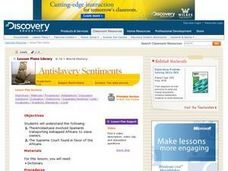Curated OER
The African Slave Trade
Provide your class with a look of the scope and context of the African Slave Trade. Graphic images of lynchings, injuries from whippings, and slave auctions will leave viewers agape with horror and ready to discuss the question on the...
Curated OER
The Antebellum South
Your history students will be on the edges of their seats during this fascinating presentation, which details the abolition movement and slave life during the Antebellum period in the American South. Students will be left agape at the...
Roy Rosenzweig Center for History and New Media
Reward: Valuable Slaves
To gain insight into the American institution of slavery and how African Americans were viewed during this time, groups examine run-away slave ads and slave auction broadsides. Teams use the provided worksheet to record their impressions...
Curated OER
Slave Auctions in South Carolina
Young scholars examine primary sources in the form of auction records, create frequency charts, graphs and diagrams that they analyze to anwer questions followed by the writing of a paper that demonstrates their comprehension of the lesson.
Roy Rosenzweig Center for History and New Media
Slaves and Indentured Servants
In theory, at least, indentured servitude and slavery were two different practices in the American colonies. Class groups conduct a close reading of two primary source documents, one written by a slave and one by an indentured servant,...
Curated OER
Examining Slave Auction Documents
Students compare the social and cultural characteristics of the North, the South, and the West during the antebellum period, including the lives of African Americans and social reform movements such as abolition and women’s rights.
Curated OER
SLAVE TRADING AND SMALL TOWNS
Students research the ways slavery shaped social and economic life in the South after 1800, the different economic, cultural, and social characteristics of slavery after 1800, and how the Atlantic slave trade finally ended.
Civil War Trust
Uncle Tom's Cabin
Through a careful reading and examination of Harriet Beecher Stowe's Uncle Tom's Cabin, scholars take part in grand conversations about the novel's contents, slavery, and the impact the book had on it. Furthermore, learners analyze an...
Curated OER
Africa: The Middle Passage and 19th Century America
Students participate in a series of activities to explore the lives of slaves in 19th century America. They examine the design of slave ships, the hardships endured, and the ways that owners depended on slaves for their economic survival.
Curated OER
EX-SLAVE NARRATIVES
Students read narratives of ex-slaves and then in groups write and act in their plays.
Curated OER
Uncle Tom's Cabin as Anti-Slavery Argument
Pupils read and discuss how African- Americans are depicted in slave auction announcements. They research how Harriet Beecher Stow responds to the sale of slaves.
Curated OER
618,000: Shall Not Have Died in Vain
Students explore the American Civil War. In this Civil War lesson, students examine a slave auction advertisement and an Abraham Lincoln quote. Students also read Pink and Say, create a foldable regarding naval warfare, and design a...
Curated OER
Olaudah Equiano
Eighth graders describe in detail a time in their life when they were the most afraid, causes of the fear and how they overcame it. This experience is compared/contrasted to the actual circumstances behind slave auction blocks. They read...
Curated OER
Slavery in Arkansas, Market to Misery
Students determine the factors that were considered when purchasing slaves at market or through the purchase of an estate. They examine the Arkansas Slave Code and share its content through a group activity.
Curated OER
The Life of Harriet Tubman
A well-designed lesson teaches about the history of Harriet Tubman, the Underground Railroad, and the issues of civil liberties. Young historians watch a video, access Internet resources, and engage in cooperative activities which should...
Curated OER
Through Their Eyes: Perspectives on Slavery
Learners write a personal account of slavery seen from the eyes of a slave trader, a slave plantation owner, a fugitive slave, or a working slave.
University of California
The Civil War: Emancipation
Investigate and analyze Abraham Lincoln's Emancipation Proclamation using primary and secondary sources. The sixth installment of an eight-part series analyzes the meaning of Lincoln's document in relation to its impact on the Civil War.
Curated OER
Simulated Underground Railroad Experience - Part B
Third graders travel throughout many stations learning about the Underground Railroad.
Curated OER
Through Their Eyes: Perspectives on Slavery
Students examine different perspectives of slavery. They write a personal account of slavery as a slave trader, a plantation owner, and fugitives and working slaves. They role-play these roles for the class.
Curated OER
Antislavery Sentiments
Students review the basic facts of the Amistad slave ship case. They are challenged to test their powers of close reading by being asked to summarize the decision handed down by the Supreeme Court of the United States in 1841. Students...
Curated OER
Slavery Lesson
Fourth graders explore the issue of slavery. In this African American history lesson, 4th graders visit a website to take a virtual journey on the Underground Railroad. Additionally, students read various suggested slave narratives....
Curated OER
Voyage to Freedom - What Does It Mean?
Fifth graders investigate the Underground Railroad by creating a quilt. In this U.S. History lesson, 5th graders discuss the history of slavery through a class "word splash" and by reading an Underground Railroad map online. Students...
Curated OER
Harriet Tubman: Dancing on the Freedom Trail
Students observe a dance interpretation about Harriet Tubman. In this art/social studies lesson, students explore how their emotions can be expressed through movement and create their own dance or dramatic interpretation.
Curated OER
Slavery
Students use primary and secondary source documents to look into the story of slavery told about "Pink". The original documents like a bill of sale for the slave is used for example. The students write notes about the research and think...

























